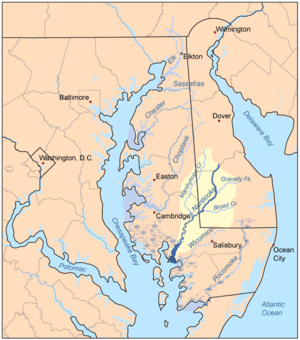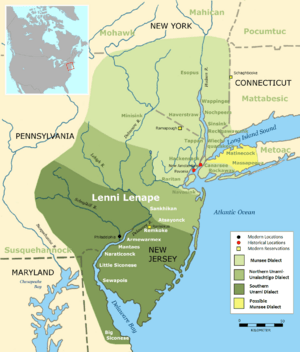Nanticoke people facts for kids
| Total population | |
|---|---|
| Approximately 1,200 in 1600 1,000 (1990) |
|
| Regions with significant populations | |
| United States (Delaware, New Jersey, Maryland, Oklahoma), Canada (Ontario) | |
| Languages | |
| English, formerly Nanticoke language | |
| Religion | |
| Native American religion, Christianity | |
| Related ethnic groups | |
| Assateague, Choptank, Conoy, Patuxent, Piscataway, Pocomoke |
The Nanticoke people are a group of Native American people. They are part of the Algonquian language family. Their original homelands were around Chesapeake Bay and in Delaware.
Today, Nanticoke people live in the Northeastern United States and Canada. You can find them especially in Delaware, Ontario, and Oklahoma. The Nanticoke people were made up of several smaller groups. These included the Nanticoke proper, the Choptank, the Assateague, the Piscataway, and the Doeg.
Contents
History of the Nanticoke People
The Nanticoke people might have started in Labrador, Canada. From there, they likely traveled through the Great Lakes area and the Ohio Valley to the east. They moved alongside other groups like the Shawnee and Lenape peoples.
First European Contact
In 1608, the Nanticoke people met Europeans for the first time. This happened when British captain John Smith arrived. The Nanticoke formed an alliance with the British. They traded valuable beaver furs with them. At this time, they lived in areas that are now Dorchester, Somerset, and Wicomico counties in Maryland.
Treaties and Land Changes
In 1668, the Nanticoke leader Unnacokasimon signed a peace treaty. This agreement was with the government of the Province of Maryland. In 1684, the Nanticoke and English governments set aside land for the Nanticoke. This land was between Chicacoan Creek and the Nanticoke River in Maryland, near Vienna.
However, other settlers started moving onto Nanticoke lands. So, in 1707, the tribe bought 3,000 acres of land. This new land was on Broad Creek in what is now Sussex County, Delaware.
Moving North and Alliances
In 1744, some Nanticoke moved to Pennsylvania. The Iroquois Confederacy allowed them to settle near Wyoming, Pennsylvania, and along the Juniata River. The city of Nanticoke is named after one of their settlements there. About ten years later, they moved further up the river.
They joined the Piscataway tribe and both groups were under the authority of the Iroquois. The land on Broad Creek was sold in 1768. Some Nanticoke moved a bit further north into New York. They created a settlement in what is now the town of Nanticoke.
French and Indian War and American Revolution
Members of the Conoy people joined the Nanticoke in the 1740s. Together, they stayed neutral during the French and Indian War. However, during the American Revolution, they sided with the British.
In 1778, about 200 Nanticoke moved north to Fort Niagara because of their alliance. The British later moved them to the Six Nations Reserve near Brantford, Ontario, Canada. They received land there as payment for what they had lost. Other Nanticoke stayed near Buffalo River in New York.
Another group of Nanticoke joined the Lenape people. They moved to Kansas and then, in 1867, to Indian Territory (which is now Oklahoma).
Places Named After the Nanticoke
Several towns and places are named after the Nanticoke tribe. These include Nanticoke, Pennsylvania, and Nanticoke, New York. Also, Nanticoke and Nanticoke Acres in Maryland are named after them.
The Winnesoccum Gathering
In the summer of 1742, members of the Nanticoke, Shawnee, and Choptank tribes gathered. They met on Winnesoccum Island in the Pocomoke Swamp in Maryland. Leaders like Chief Robin Hood and Hopping Sam brought their people to the swamp for six days. They discussed their experiences with the English settlers.
As all the tribal members, including women and children, left their villages, the colonists became suspicious. Soldiers were sent to find the tribes in the swamp. The tribal leaders were questioned by the English. Each leader told a different story about why they had gathered. Some said they were only hunting, while others said they were electing a new chief.
The English decided that since no attacks had happened, no harm should come to the tribes. A peace treaty was signed on July 24, 1792.
What "Nanticoke" Means
The Nanticoke people call themselves Nentego. This name means "Tidewater People." The Nanticoke had different groups, or chiefdoms. These were the Wicomoco, Monie, and Manokin, named after the rivers they lived near.
The Nanticoke had a large trading network. They traded with many tribes throughout the Chesapeake Bay area. Early records describe some Nanticoke groups as the Arseek, Cuscarawoc, and Nause.
Nanticoke Language
The Nanticoke language was different from other Algonquian languages spoken in Maryland. Sadly, the Nanticoke language is now extinct. The last known speaker, Lydia E. Clark, passed away in 1856.
Today, tribal members and language experts from Georgetown University are working to bring the language back.
Nanticoke People Today
Today, some Nanticoke people are part of the Six Nations of the Grand River First Nation in Ontario, Canada. This group is recognized by the Canadian government. The Nanticoke who moved west with the Delaware are part of the Delaware Tribe of Indians in Oklahoma. This tribe is recognized by the U.S. federal government.
The Nanticoke Indian Association in Millsboro has been a state recognized tribe in Delaware since 1922. The Nanticoke Lenni-Lenape Indians are a state-recognized tribe in New Jersey.
Nanticoke Indian Association
In 1744, some Nanticoke settled near the Indian River in Delaware. They later formed the Nanticoke Indian Association. The state of Delaware recognized them as a tribe in 1881. Their main office is in Millsboro.
In 1922, they became a non-profit organization. They used to hold yearly powwows, which are Native American gatherings. These stopped in the mid-1930s during the Great Depression. In 1977, the tribe brought back the annual powwow. Later, they built a museum to honor their history. This museum helps teach their children and others about their heritage.
Several places linked to the Indian River Community were listed on the National Register of Historic Places in 1979. These include the Robert Davis Farmhouse, Harmon School, Isaac Harmon Farmhouse, Harmony Church, Ames Hitchens Chicken Farm, Indian Mission Church, Indian Mission School, Johnson School, Coursey and Daisey Indian Burial Ground, and Warren T. Wright Farmhouse Site.
In 2002, Kenneth S. "Red Deer" Clark Sr., the head chief, and his son "Little Owl" Clark, the Assistant Chief, stepped down. "Tee" Norwood was elected chief and served until 2008. Larry Jackson became chief in 2008, and Chief William H. "Thunder Eagle" Daisey led until 2016. Natosha Carmine was chief from 2016 to 2023. Avery "Leaving Tracks" Johnson is the current chief as of 2023.
Nanticoke Lenni-Lenape Indians
Some Nanticoke people settled across the Delaware Bay in southern New Jersey. There, they joined the Lenape people and married into their families. The Nanticoke Lenni-Lenape Indians of New Jersey are recognized by that state. Their base is in Bridgeton.
Many members of this group have mixed Nanticoke and Lenape ancestry. Both tribes historically spoke Algonquian languages. They have a long history of intermarriage between them.
|
See also
 In Spanish: Nanticoke para niños
In Spanish: Nanticoke para niños
- Nanticoke language
- 1666 Articles of Peace and Amity
- Ahone
- Assateague people
- Choptank people
- Doeg people
- Harmon School (Millsboro, Delaware)
- Isaac Harmon Farmhouse
- Harmony Church
- Indian Mission Church
- Nanticoke Indian Association
- Oak Orchard, Delaware
- Warren T. Wright Farmhouse Site
- Indigenous peoples of Maryland
- Nacotchtank
- Unalachtigo Lenape
- Native Americans



